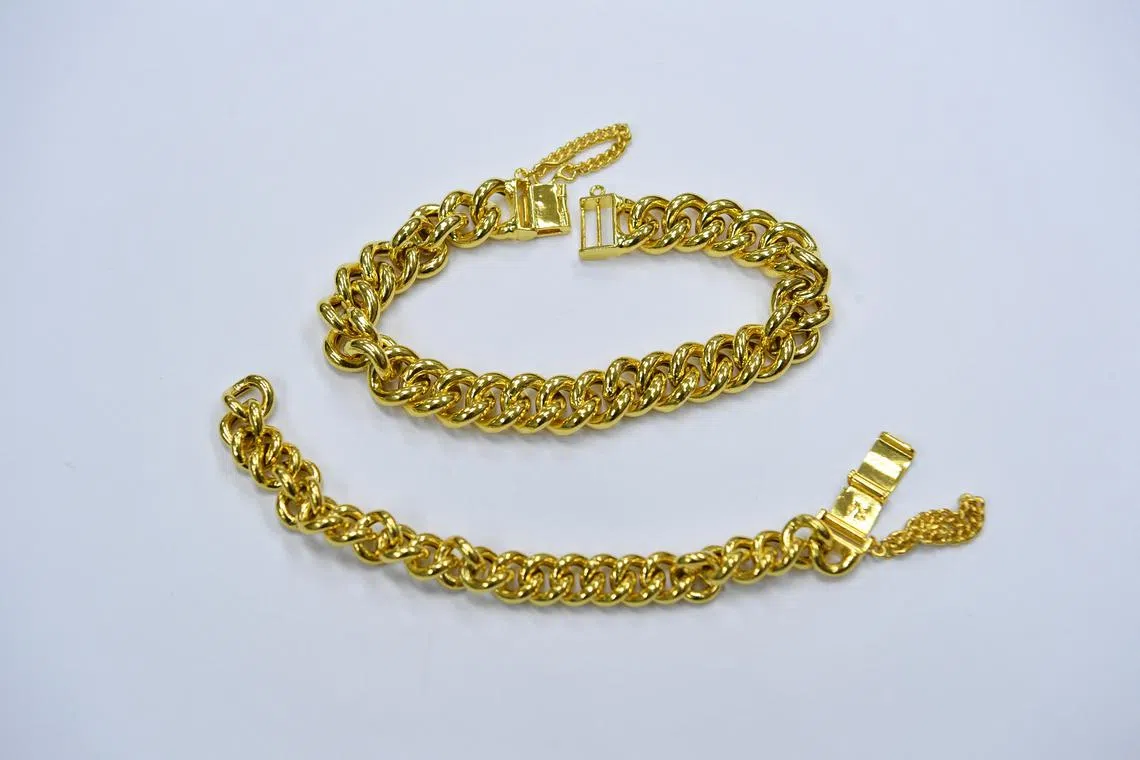Why two gold bracelets failed the purity test
Sign up now: Get ST's newsletters delivered to your inbox

Tests show that these two gold bracelets do not meet the required gold benchmark quality of 91.6 per cent gold content.
ST PHOTO: CHONG JUN LIANG
Follow topic:
SINGAPORE - Two gold bracelets which look nice and shiny but have a serious defect that the naked eye could not detect were given a “fail” rating by the Singapore Assay Office (SAO).
The office gave the rating to the jewellery because the gold content was less than the 91.6 per cent benchmark for 916 or 22K jewellery.
An X-ray test showed that their gold content was 90.9 per cent, or a mere 0.7 percentage points short. It may sound petty to nitpick over a fraction of a percentage point, but this has implications on the integrity of the gold business – customers do not like to be short-changed.
So, if a bracelet weighs 20g, it should contain gold worth at least $1,410, based on the current price of the precious metal. But the shortfall means it is worth $1,399, or $11 less.
That seems like small change, but a shipment containing 1,000 bracelets would have a shortfall in gold of a hefty $11,000.
When such cases happen, the fault usually rests with either the supplier or the refinery, and not the goldsmiths, who would want to verify the gold content of the items they sell.
Goldsmiths do not want to be taken for a ride by their suppliers; more than that, they do not want to be accused by customers of selling “sub-standard” jewellery.
Invest learnt that the owner of an overseas refinery once took issue with such reports by the SAO, saying he had been running his business honestly for decades.
But the irrefutable scientific data was proof that all was not well. The owner later found out that one of his employees had been tampering with the gold content at his refinery.
The SAO’s senior manager, Mr Yap Jian Jie, says that apart from jewellery with less than the declared gold content, it has also come across pieces that have “inserts” such as lead within hollow spaces in the gold.
Jewellery that have been tampered in this manner come mostly from overseas dealers, so you should think twice before shopping at unknown jewellers when you are holidaying, no matter how great the bargain.
Some dubious pieces may also use toxic alloying elements such as thallium and cadmium to improve melting characteristics. Wearers of jewellery with prohibited elements risk encountering skin or other health complications.
Important to deal with reputable dealers
Until someone develops an affordable, portable gold scanner – they cost tens of thousands of dollars each now – you should buy gold only from reputable sources because even 99.99 gold bars that come with serial numbers can be tampered with.
While such cases are not common, Mr Victor Foo, the chief executive of the Singapore Precious Metals Exchange, recently came across some bars from an overseas refinery that appeared dodgy.
Checks were done on the customer’s stash of 50g “pure” gold bars, and some failed the tests, meaning that they were not made with pure gold.
Invest understands that the bars were first put through an X-ray test with a handheld spectrometer, which should display “99.99 Au”, or Aurum, gold’s chemical name, for pure gold bars. The bars passed this test, but some failed the ultrasonic test, which suggested that there was impurity within the bars that could not be picked up by the X-ray scanner.

Tests such as X-ray and ultrasonic tests on gold bars will reveal tell-tale signs if the bars are not made of pure gold.
ST PHOTO: LIM YAOHUI
Heavily gilded tungsten has been passed off as gold. Such fraud is possible because tungsten, a far cheaper metal, has a very similar density to gold. As sound waves travel faster through tungsten than gold, the scan will pick up tungsten if it is present, resulting in a “failed” reading.
This apparently happened to some of the customer’s gold bars. As a result, he was advised to send the bars back to the refinery and ask for a refund. A full refund was paid but the refinery disputed allegations that the bars had impurities.
However, Mr Foo stands by his test. In a demonstration to Invest, the same ultrasound scanner was able to accurately give a “pass” reading for a 99.99 pure gold bar but a “fail” reading for a gold ornament that is usually mixed with other alloy.
“You cannot tamper with science,” says Mr Foo. “This is why we will remove even 99.99 bars from their casings to test them in order to safeguard the integrity of our business. Such tests eliminate the possibility of adulterated bullion passing into our exchange.”
Expert’s three tips for those keen on collecting gold bars
Buy only from dealers who get their supply from accredited mints.
Make sure you always keep proper receipts and proof of purchase or ownership. Such documents can help you to get back your money if there are disputes later.
Where possible, always check and test your physical holdings. The Singapore Assay Office can authenticate your gold for an affordable fee.


